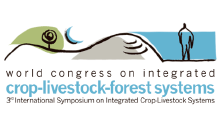Article: Ecological intensification, agriculture for a new world
Article: Ecological intensification, agriculture for a new world
Inácio de Barros
Embrapa Researcher
Perspectives suggest that a true revolution in agricultural production processes will have to happen. While on one hand the production model has shown its limits, especially with respect to the unsustainable use of natural resources and the negative impacts they cause on the environment, on the other hand it is estimated that the world population will grow from seven to nine billion people in 2050, increasing the demand for food, fiber, wood and biofuels.
This increase will be even bigger than a direct progression of population growth, as a substantial improvement in the quality of life of less favored populations is expected. That will inevitably entail an increase in the per capita use of agricultural products.
The solution adopted for millenia to cope with the increase in the demand for agricultural products − deforestation and agricultural expansion − is simply no longer possible. There are few reserves of arable lands, and deforestation is associated with changes that threaten both agriculture itself (more pests, reduced pollinization as a result of the reduction of bees, soil erosion, etc.) and loss of biodiversity and climate change.
The challenge is then clearly posed: how to meet the demand for agricultural products from a bigger population with better quality of life, sustainably, without increasing the cultivated surface, and with lower availability of water and fossil energy? To respond to this challenge, a new a proposal appeared in France at the end of the first decade of the 21st century - Ecological Intensification (French translation) or Sustainable Intensification (British translation) of Agriculture.
Such model aims at creating conditions to intensify natural mechanisms within ecosystems instead of directly boosting production with inputs. This entails, depending on the case, the elimination or reduction of harrowing and plowing in order to thus optimize the functioning of the soil; use of cover crops to favor the development of earthworms and fix carbon; the practice of an improved fallow system to maximize the photosynthesis period, the production of biomass, and biological nitrogen fixation, or also the practice of biological pest and disease control to conserve biodiversity. This model does not exclude the use of pesticides, fertilizers, or genetically modified organisms, but these are much more rationally implemented, only as a complement to agroecological best practices, in order to guarantee gains in environmental quality without compromising profitability.
Integrated crop-livestock-forest systems (ILPFS) are a typical example of agricultural production systems based on the principles of Ecological Intensification (or Sustainable Intensification). In ICLFS, ecosystems' natural mechanisms are channelled to favor the production system: the different species present (annual crops, pastures, and forest essences) have roots that explore soil resources at different depths, thus preventing competition and favoring niche complementarity in the use of water and mineral nutrients. The presence of different root exudates also helps to capture leached substances and reassemble nutrients.
With regard to the aerial part, the different levels of canopy propitiate better capture and more efficient use of sun radiation, and a soil cover that reduces water and soil losses due to erosion and/or evaporation, in addition to reducing competition with weeds. The existing biodiversity has the potential to promote beneficial mechanisms like symbiosis (Biological Nitrogen Fixation; mycorrhizal association) and allelopathy to help control invading plants, in addition to favoring the presence of natural pest enemies and offering physical and genetic barriers to the dissemination of diseases.
An ecologically intensive agriculture also entails a more complex management of agricultural techniques and spatial organization than the one used today, applying these techniques and organization to the most different levels of management of the agroecosystem - ranging from the place to the landscape. Thus, this kind of agriculture is intensive not only with regard to ecological functionalities, but it also requires strong intensification of knowledge, a holistic vision of the production process, and an integrated management of the different users of the ecosystems concerned. There undoubtedly lies a major and necessary evolution.
Inácio de Barros
Embrapa Coastal Tablelands
Further information on the topic
Citizen Attention Service (SAC)
www.embrapa.br/contact-us/sac/

